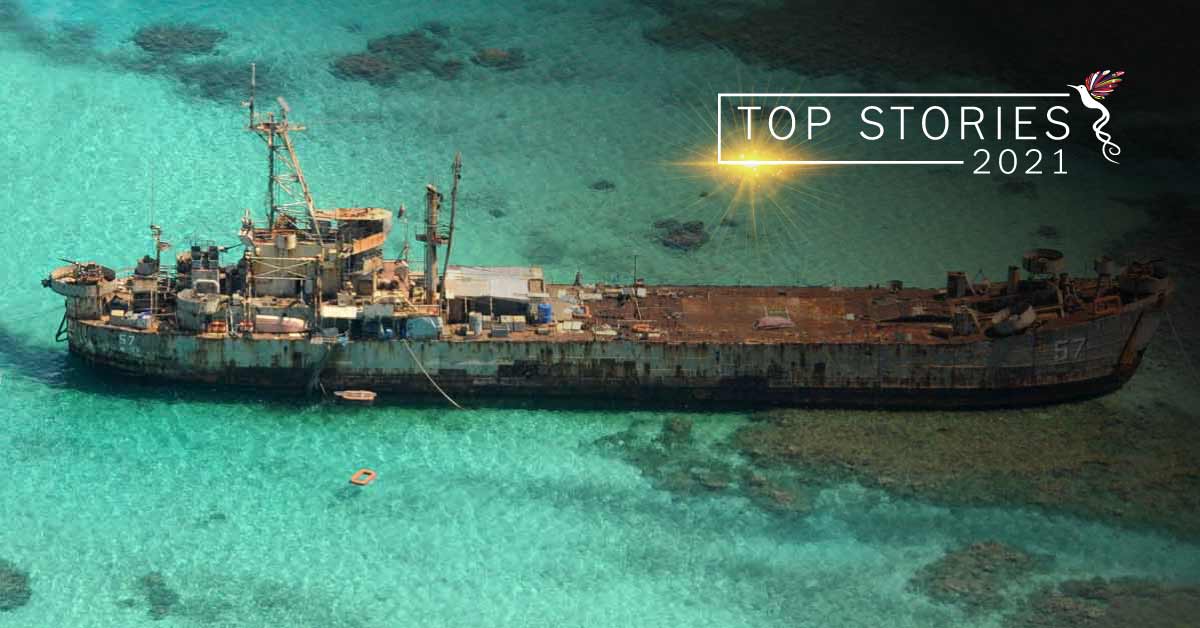The South China Sea (SCS), one of the most in-demand waterways in the world, is the object of contention of several claimant states with overlapping territorial and maritime sovereignty and sovereign rights claims over the disputed waters. The dispute is still unresolved today and can be dated back to the 1950s.
The six-primary claimant states of the contested waters of the SCS are China, Vietnam, Malaysia, Brunei, the Philippines, and Taiwan. Through the years, these states have claimed islands or reefs in the contested waters of the SCS.
The claims are based on historical and geographical accounts and varying interpretations of international law. Some claimants base their claims of an Exclusive Economic Zone (EEZ) on historical grounds while others refer to the United Nations Convention on the Law of the Sea (UNCLOS).
The tensions over the disputed SCS, time and again have been heightened by unbridled nationalism and by the great power rivalries and competition between the United States (US) and China in the Indo-Pacific region.
Since the SCS is a disputed area, claimant states have been involved from time to time in minor naval clashes and skirmishes, usually concerning the forced removal of sea vessels from claimed territorial waters.
For instance, China and Vietnam had serious military clashes in 1974 and again in 1988 over occupations in the Paracel Island group, while the Philippines and China had a standoff over the Scarborough Shoal in 2012.
Recently, territorial/maritime disputes between the Philippines and China in the South China Sea (SCS) have dominated both international and local headlines.
Last Tuesday (16 November 2021), it was reported that three Chinese cast guard vessels had fired water cannons on two Philippine boats delivering supplies to Filipino marines stationed in the Ayungin Shoal, forcing them to discontinue their mission. No one was hurt in the incident.
The Ayungin (in Tagalog) Shoal or Atoll in the Spratly Islands also known as the Second Thomas Shoal or Rén'ài Jiāo (in Mandarin), is a disputed area in the SCS being claimed by the Philippines and China. The shoal is 105 nautical miles west of Palawan, a province in the Philippines and is currently occupied by the Philippine military.
Reactions
Secretary of Foreign Affairs Teodoro L Locsin Jr expressed his indignation and reminded China that a public vessel is covered by the Mutual Defense Treaty (MDT) between the Philippines and the US.
“I have conveyed in the strongest terms to Ambassador Huang Xilian and to the Ministry of Foreign Affairs in Beijing our outrage, condemnation, and protest of the incident. I reminded China that a public vessel is covered by the Philippines-United States Mutual Defense Treaty,” Locsin said.
On the other hand, China responded and defended its actions saying that it acted to “safeguard China’s sovereignty”. The Foreign Ministry Spokesperson Zhao Lijian's in a regular press conference on 18 November, 2021 (Thursday) said that “On the evening of November 16, two Philippine supply boats trespassed into waters near Ren'ai Jiao of China's Nansha Qundao without China's consent. Chinese coast guard vessels performed official duties in accordance with law and upheld China's territorial sovereignty and maritime order. At present, the sea area of Ren'ai Jiao is generally tranquil. China and the Philippines are in communication on this.”
Vice President Leni Robredo, who is also one of the presidential aspirants in the 2022 Philippines elections joined the fray. "This kind of treatment of Filipinos must stop. West Philippine Sea (WPS) is ours as the arbitration tribunal ruled in July 2016," Robredo said in a statement.
PCA Ruling
Without a doubt, the 2016 Permanent Court of Arbitration (PCA) ruling or award was a moral victory for the Philippines.
Moreover, as a proviso, the PCA ruling did not denote the victory of sovereignty (ownership) over the territorial and maritime claims of the Philippines in the disputed waters of the SCS. Precisely because the arbitral tribunal did not tackle matters related to territorial sovereignty over the disputed maritime features between the parties, which further means that the tribunal did not decide who owned the maritime features located in the SCS, such as the Spratly Islands, that are claimed by China and the Philippines and even Vietnam and Malaysia as well.
Similarly, the tribunal did not delimit (demarcate or set limits) any maritime boundaries between the Philippines and China in the SCS.
The award simply clarified the maritime entitlements of the Philippines in the West Philippine Sea (WPS), declared the nine-dash line of China as being without basis, acknowledged the damage to the marine ecosystem and resources caused by reclamations in the SCS.
Likewise, the 2016 PCA ruling also concluded that Second Thomas Shoal is, or in its natural condition was, exposed at low tide and submerged at high tide and, accordingly, has low-tide elevations that do not generate an entitlement to a territorial sea, exclusive economic zone (EEZ) or continental shelf.
However, Second Thomas Shoal sits within 200 nautical miles of the Philippine coast and is, therefore, part of the EEZ and continental shelf of the Philippines. Thus, the Philippines has sovereign rights over it because it is part of its EEZ but it does not have sovereignty over it. Sovereignty and sovereign rights are two different things.
According to UNCLOS, sovereignty bestows full rights, or supreme authority, on a country within its territorial waters, which stretch to 12 nautical miles. Sovereign rights in an EEZ, which are much further out to sea, “no longer concerns all of a state's activities, but only some of them.
Megaphone Diplomacy
Locsin – who has been known for his “megaphone diplomacy” – has called out China over the recent skirmish in the SCS between the Philippines and China.
While it is one thing to file a diplomatic protest against China over the recent skirmish in the SCS involving the two countries, which is justified and a legitimate action on the part of the Philippine government; it is another to blow out of proportion the incident by unnecessarily citing the MDT between the Philippines and the US as if the Philippines and China are on brink of war which is not the case at all.
Mentioning the MDT and the insinuation behind it is quite an exaggeration of the situation and uncalled for given the sensitivity and complexity of the SCS issue.
Hence, Locsin’s “megaphone diplomacy” is at odds with the so-called “bilateral and multilateral quiet/peaceful diplomacy” of the Duterte administration with regards to China over the SCS given the complicated nature of the dispute. It seems that instead of calming the situation to prevent further crisis and escalation in the SCS, Locsin was deliberately fanning the flames of discontent.
Coincidences?
What was Locsin trying to accomplish by mentioning the MDT? Is the incident another case in point of trying to justify the ongoing negotiations between the Philippines and the US to add, establish, and resume the construction of more US military facilities and to preposition more US military and defense assets inside Philippine military bases in the name of the so-called China Threat theory?
Just recently, Philippine diplomatic and defense officials met in Washington DC for two days (15 and 16 November) and outlined a joint vision statement to reinvigorate bilateral relations between the Philippines and the US.
A part of the Joint Vision Statement for a 21st Century United States-Philippines Partnership states that, “We intend to continue to implement infrastructure projects at current EDCA locations and explore additional sites for further development.”
The Philippines allowed the US to establish facilities and preposition defense assets inside Philippine military bases under the Enhanced Defense Cooperation Agreement (EDCA) in 2014. EDCA is an agreement between the Philippines and the US that complements the Visiting Forces Agreement (VFA), which bestows diplomatic immunity to US soldiers coming to the Philippines.
At the moment, the location of some US forces, facilities and defense equipment, and assets in the country are in Basa Air Base, Fort Magsaysay, Antonio Bautista Air Base, Mactan-Benito Ebuen Air Base, and Lumbia Air Base which are strategically located to serve US strategic security interests and purposes.
The Joint Statement was signed by Ambassador Jose Manuel G Romualdez and Undersecretary of National Defense Cardozo M Luna for the Philippine Government, and Assistant Secretary of State for East Asian and Pacific Affairs Daniel J Kritenbrink and Assistant Secretary of Defense for Indo-Pacific Security Affairs Ely S Ratner for the US Government.
It is interesting to note that the circumstances that led to the signing of the EDCA on 28 April, 2014 were exactly analogous to the recent incident in the SCS involving the Philippines and China.
Roughly a month before the signing of the EDCA, around March 2014, an incident happened in the SCS involving China and the Philippines. China's coast guard prevented two Philippine civilian vessels from delivering supplies to the Philippine Navy craft BRP Sierre Madre, which was stationed at the shoal since 1999 to serve as a permanent outpost of the Philippines in response to the Chinese reclamation of Mischief Reef.
The incident created tensions between the Philippines and China with the Philippines and the US calling Beijing's actions provocative.
Roughly a month after the incident, on 28 April, 2014, the EDCA was signed.
Philippine supply ships usually avoid Chinese blockades to deliver food, water, and other supplies to the stationed ship in Ayungin Shoal to avoid confrontation with the Chinese coast guard. Even after the incident in March 2014, the Philippine military has been sending monthly relief missions in the form of air-dropped provisions to troops stationed in the area.
Are the incidents that took place on March 2014 and 16 November, 2021 mere coincidences or is there more to it?
Conclusion
In retrospect, instead of seriously considering the abrogation of the lopsided MDT, VFA, and EDCA –given that these agreements have skewed provisions more favourable to the US than the Philippines – it seems that the US is being given additional latitude as negotiations on the construction of US military facilities and more prepositioning of US defense assets and materials are underway.
Maintaining the VFA, EDCA or even the MDT is an anti-thesis to the Philippines’ pursuit of an “independent foreign policy and non-aligned stance”. These agreements are symbols of US domination in the country, reminders of a colonial-era long gone and the interventionalist agenda of the US. The presence of US military forces in the country is a remnant of colonialism that Filipinos should put an end to.
The Philippines should take control of its destiny as a nation and steer away from being the ever-perpetual lackey of the US. It should strive to be a truly independent, sovereign nation that decides its course as it navigates the changing geopolitical landscape in the region.
To avoid further skirmishes in the SCS between claimant states, the Philippines and China together with ASEAN member states should work towards the adoption and conclusion of the Code of Conduct (COC) for the SCS. Though the COC is not a mechanism that will settle sovereignty disputes, it will provide rules and guidance on right conduct at sea among claimant states to avoid further incidents and confrontations in the SCS.
Articles selected as Top Stories of 2021 are those that were the most popular among readers of The ASEAN Post for the month in question.
The views expressed in this article are the author’s own and do not necessarily reflect those of The ASEAN Post.

